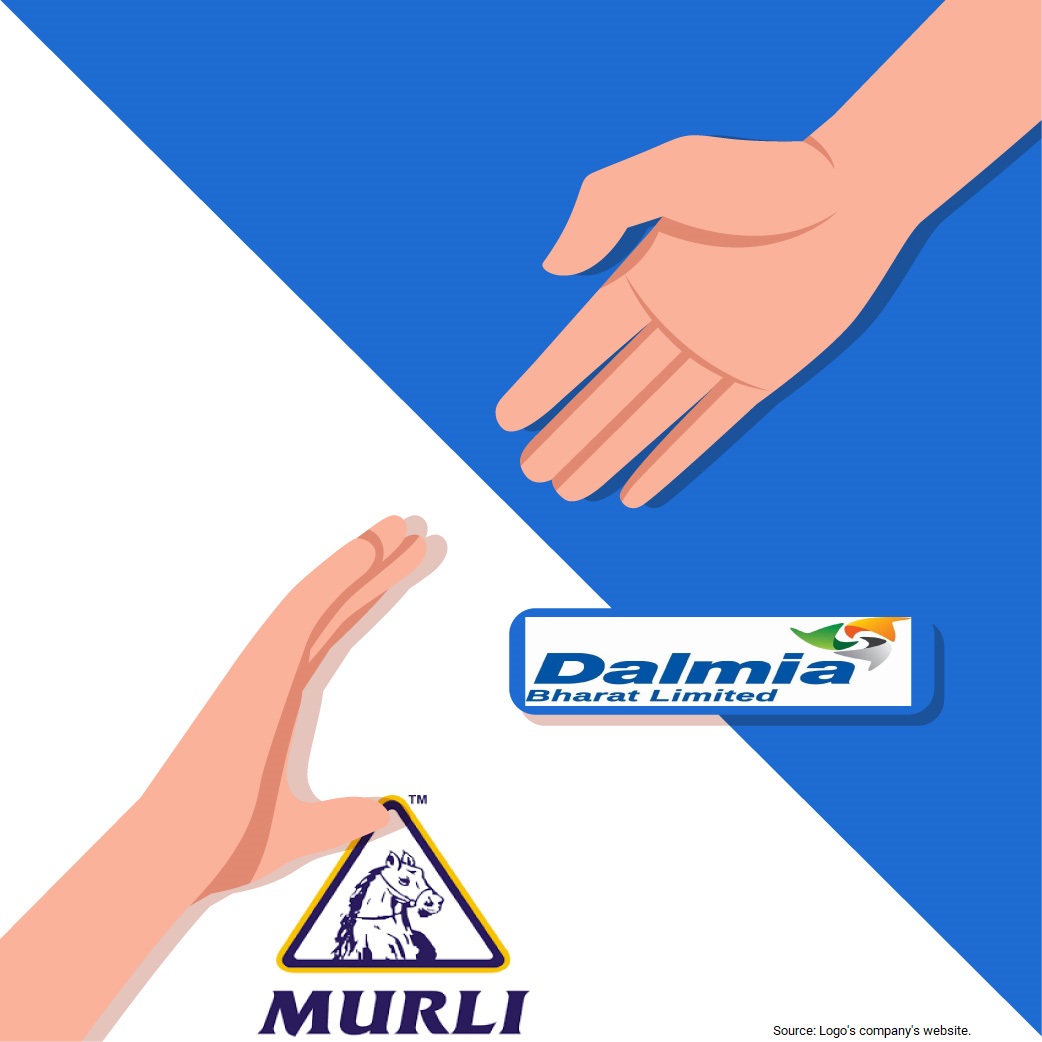After a long-drawn case, the National Company Law Tribunal (NCLT) Mumbai has given approval to Dalmia Cement (Bharat) regarding the resolution plan for the revival of Murli Industries.
Dalmia Cement (Bharat) Ltd is a one of the prominent player in the cement manufacturing industry and is a wholly-owned subsidiary of the Dalmia Bharat Ltd who is listed on stock exchange having a market cap of Rs 18,738 crore (approx.)
Murli Industries Ltd. has an integrated cement manufacturing plant with an installed capacity of 3MT in Chandrapur district, Maharashtra along with the captive thermal power plant of 50mw. In addition, Murli Industries also has paper and solvent extraction units in Maharashtra. The operations of the Murli Industries (Corporate Debtor) came to stand still during FY 2015-16.
IBC Process against Murli Industries Ltd
Section 7 application filed by one of the financial creditor Edelweiss Asset Reconstruction Company Limited (EARC) was admitted by NCLT and Corporate Insolvency Resolution Process (CIRP) was started against Murli Industries. Resolution plan as submitted by Dalmia Cement is approved by Committee of Creditors (CoC) with 100% voting shares and creditors are getting Rs 402 crore for their claim of Rs 3,171.26 crore. NCLT approved the plan with couple of modifications in the resolution plan. The various issues and observation made by NCLT in the resolution plan is covered in this article.
Various hurdles in Resolution plan approval
Couple of applications filed with Adjudication authority (NCLT) for rejecting the resolution plan. Major concerns of the applicant were noted below along with comment from NCLT on the same.
| Sr.no | Objection / concerns of applicants | NCLT Judgement |
| 1. | The Resolution applicant wanted to run only Cement undertaking as a going concern and sell the paper and solvent extraction units of the business. | Resolution plan is approved by 100% voting share of CoC, it is presumed that the commercial wisdom is exercised by the CoC while approving the plan.Therefore, NCLT is not inclined to interfere with the same. |
| 2. | The Resolution Plan does not provide for the payment/ retrenchment benefit to be extended to employees/ workmen of the paper and solvent extraction undertaking. The plan proposed closure of these units without any compliance prescribed under Industrial Dispute Act, 1947. | The workmen and employees of all the undertakings shall be treated strictly as per the Industrial Disputes Act, 1947. The closure of undertakings shall comply with all applicable laws. No exemptions/ relief can be granted in this regards. |
| 3. | Plan includes granting of mining lease license and with various other conditions which are to be given by state government. | Such a wider approval cannot be granted by this Adjudicating Authority, and the Resolution Applicant must comply with the directions of government regulations. |
| 4. | The resolution plan entitles Dalmia to seek suitable modification or withdrawal of the plan and exercise its rights under applicable law. | The Resolution applicant shall not be allowed to modify or withdraw the plan without an order from this Adjudicating Authority |
| 5. | The resolution applicant has also proposed that the management and control of the Corporate Debtor will be through Deloitte Touche Tohmatsu India LLP (during implementation period) | Not acceptable since this entity cannot exercise the powers of the board of the corporate debtor. |
| 6. | The resolution plan is conditional to the fulfilment of various conditions, approvals from various authorities etc | The said reliefs and concessions are not granted and approvals of various authorities are to be taken. |
| 7. | The Resolution Applicant has sought extinguishment of all claims. | Only crystallised liabilities of the Corporate Debtor shall stand extinguished on the approval of this resolution plan. The contingent liabilities shall exist, and no waiver can be provided for them. |
| 8. | Objections relating to commercial wisdom of financial creditors | The objections relating to commercial wisdom of the resolution plan approved by Financial Creditors with a vote share of 100% cannot be entertained by this Adjudicating Authority. |
| 9. | Application filed by promoter & member of suspended board of directors under Sec 12A (withdrawal of CIRP proceeding) | Application cannot be considered since the same has to be filed by the Resolution Professional only after the approval of CoC with 90% vote share and is therefore rejected. |
| 10. | Allegation against the RP inefficient in performing his duties | The conduct of the RP can only be challenged by CoC, and erstwhile promoters/directors have no locus for doing the same. |
Suggestion to Government by NCLT member
- Approval of the shareholders of the Financial Creditors –Employees of the banks normally authorized by the directors to exercise their voting rights in the CoC meeting even though the haircut is huge. The Board of Directors has a fiduciary duty to the Shareholders. In such a situation, the approval of shareholders of the Financial Creditors may be made mandatory.
- Approval of the shareholders of the Resolution Applicant – Since in any merger, demerger, schemes of arrangement under section 230-232 of Companies Act, 2013, irrespective of the amount involved, approval of the shareholders of the transferee company is a must. By extending the same analogy, approval of shareholders of Resolution Applicant, which is akin to transferee company may be made compulsory.
Major takeaways
- There is a common practice noticed that resolution applicant through a resolution plan try to get exemption from compliance /approval of various applicable laws for taking over the company. NCLT is not granting these considering resolution under IBC and asks the applicant to comply with the same.
- Resolution plan once approved by Adjudication Authority is binding on all the parties including the resolution applicant and cannot be modified/withdrawn by Resolution applicant without the order of Authority.
- On approval of the resolution plan, power of boards of directors are re-instated and handed over to the new management. The said company shall no longer be controlled by Resolution Professional or his team, although they can be in monitoring committee which oversees the implementation of the plan.
- When a resolution plan is approved by CoC with 66% or more voting share the commercial wisdom of the CoC is not allowed to be interfered with by Adjudication Authority *
- There is no waiver for contingent liabilities and they cannot be extinguished through a resolution plan.
*(Case Ref K Sashidhar & Indian Overseas Bank & Ors. [Civil Appeal No. 10673/2018], Supreme Court)
Judgements in other IBC cases:
Arcelor Mittal bid for Essar Steel:
- Appellate Tribunal had given financial creditors equal status with operational creditors in the distribution of the ArcelorMittal’s bid amount of Rs 42,000 crore.
- Financial creditors will get 60.7 % of their admitted claims of Rs 49,473 crore, almost same as operational creditors.
- Further tribunal also highlighted that CoC has no role in distribution.
- CoC challenged the NCLAT order in Supreme court and order is put on hold.
Recently IBC code also got amended and makes it clear that financial creditors will be paid in priority over other creditors and payment will be as per waterfall payment as provided in Sec 53 of the IBC.
Murli Acquisition cost:
| Particular | Remark |
| Amount paid for acquisition | Rs. 402 crore |
| Murli Plant Capacity | 3 million tonnes annual |
| Cost Per Tonne | Rs. 1,340/- |
| Additional capex (as per management) | 350 crs |
| Probable Cash outflow in next 2 -2.5 Yrs | 65%-70% i.e. Rs.488– Rs.526 crores (approx.) |
| Balance over period of subsequent next 3-4 yrs | Rs. 225 – 260 crores (approx.) |
Comparison with other acquisition:
| Particular | Cost /Tonne |
| Dalmia acquire Murli Ind | 1,340 |
| Dalmia acquire Kalyanpur Cement | 2,800 |
| Ultra Tech Acquire Binani cement | 9,299/- |
| Century Textile (Cement business) | 6,073/- |
A good buy?
- Murli Industries is located in Maharashtra and currently, Dalmia does not have any plant in this region and it will help to cater the western region for Dalmia.
- In addition to cement undertaking, Dalmia is also getting paper and solvent extraction undertaking which Dalmia is considering to sell off.
- Contingent Liability dilemma: No waiver is provided from the contingent liabilities of the Murli industries to the Dalmia cement, and in the absence of any surety, there may be uncertainty regarding possible future cost towards this acquisition.
- Tax benefits are also denied by the NCLT.
- Since limestones mines were not reinstated and Dalmia have to take necessary permission and approval from the government. Operating the Murli plant in full capacity with its existing limestone reserve or participate in fresh bidding/ auction of limestone is to be evaluate along with its related cost.
Conclusion
Resolutions under IBC are happening in cement, steel and infrastructure industries mainly for three reasons. One because these industries are capital intensive, two lead time to start greenfield project is too high and three in these industries technology changes are few and only incremental.
Almost all acquisitions are by strategic acquirers because it only can extract synergies and revive the target company in cost efficient manner. The latest acquisition by Dalmia will have synergies in terms of geographical presence, huge cost advantage. Quick integration will generate enough cash flow to have payback period of half of greenfield/brownfield expansion.





Add comment